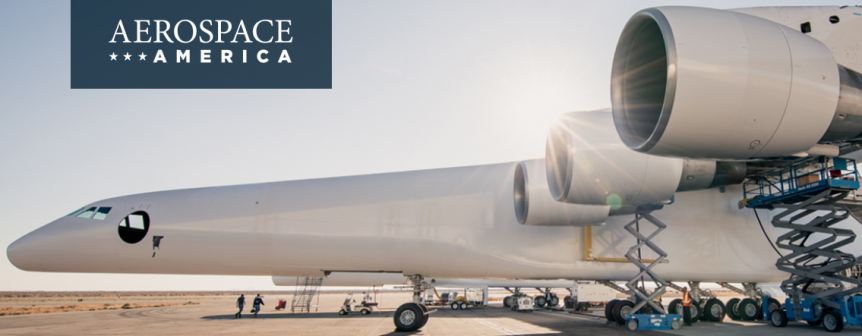The designers of Stratolaunch faced a daunting task six years ago when they set out to conceive an aircraft that could fly to the stratosphere and release a reusable rocket that would blast into orbit payloads weighing up to a combined 250,000 kilograms. They needed to ensure that the design of the plane’s massive wings and fuselage weighed no more than necessary to meet safety and manufacturing requirements.
They’ll soon find out whether any adjustments might be required. Stratolaunch Systems, based in Seattle and backed by Microsoft co-founder Paul Allen and Scaled Composites founder Burt Rutan, is ground-testing the plane’s six Pratt & Whitney PW4000 engines in anticipation of a first flight over Mojave, California, in a few months, followed by a first space launch planned for 2019.
Mojave-based Scaled Composites, which is building Stratolaunch, began using Collier Research Corp.’s HyperSizer design software at the start of design in 2011. Craig Collier led the NASA team that developed HyperSizer starting in 1988. The software was commercialized in 1995. Scaled Composites licensed the software, and its stress-team engineers used it. Government and industry engineers have applied it to some big-name projects, including the design of NASA’s now-defunct Ares 5 rocket, the heat shield of the Orion crew module and the Spirit Aero/Bell Helicopter V280. Now president of Collier Research in Virginia, Collier says the software typically reduces weight of structures by 20 to 40 percent from designs done without HyperSizer.
“As flight testing begins and small improvements to the airframe are made, HyperSizer will continue to be used,” Collier says.

Stratolaunch was a distinctive challenge partly because its 117-meter wingspan made it the biggest airframe HyperSizer has been applied to, Collier says. The magnitude of loading resulted in thick laminates and a high count of plies, says Collier. “For the massive Stratolaunch wing, deflection limits were a significant factor to be taken into account,” he adds. Deflection limit is the maximum degree a wing can be bent without risking failure. No other aircraft has ever reached even 100 meters in wingspan.
Scaled Composites’ stress team consulted HyperSizer’s comprehensive set of automated failure analyses that included rapid free-body analysis and discrete laminate sizing.
While having convenient features such as the ability to upload data from Excel software, the core of HyperSizer’s approach is Finite Element Analysis. The software simulates the behavior of engineering structures and components under a variety of conditions to demonstrate stress, strain, the influence of temperature and pressure, and other factors.
Collier says that HyperSizer applies the same analytical methods in optimization that are used for final certification. “This produces optimum designs that do not have to change later as design matures from preliminary to final. And it allows analysis certification reports to be generated at any time during design.”

